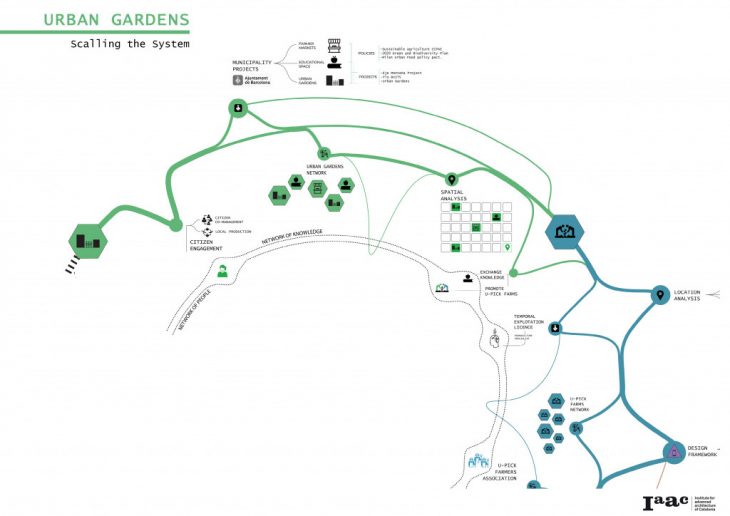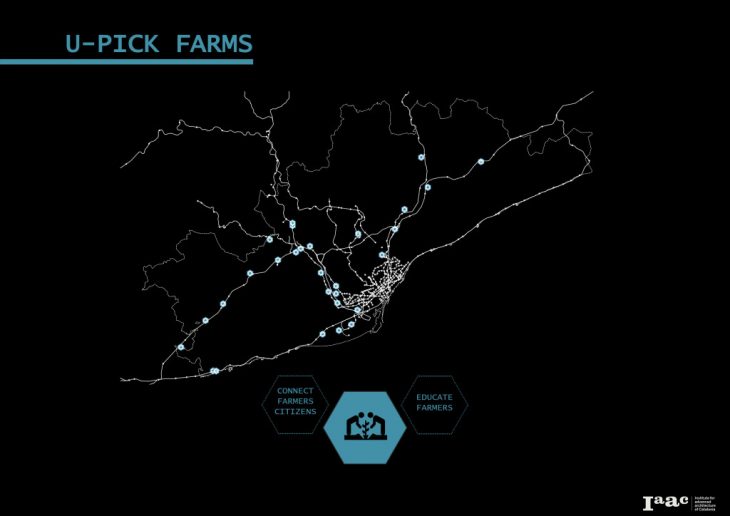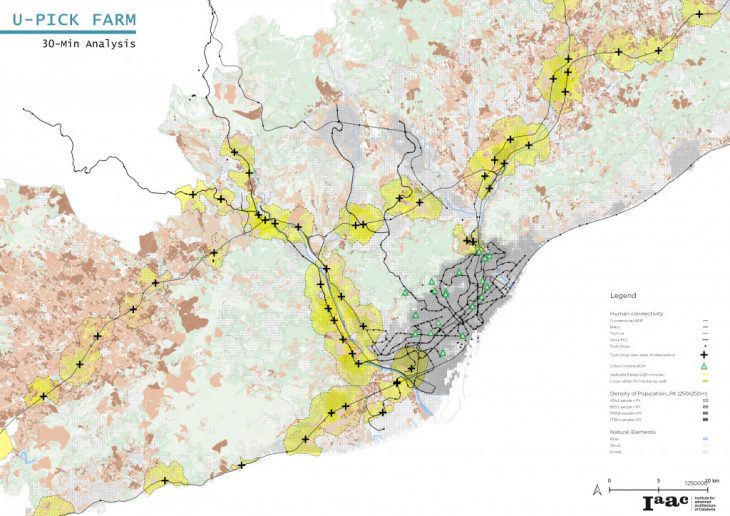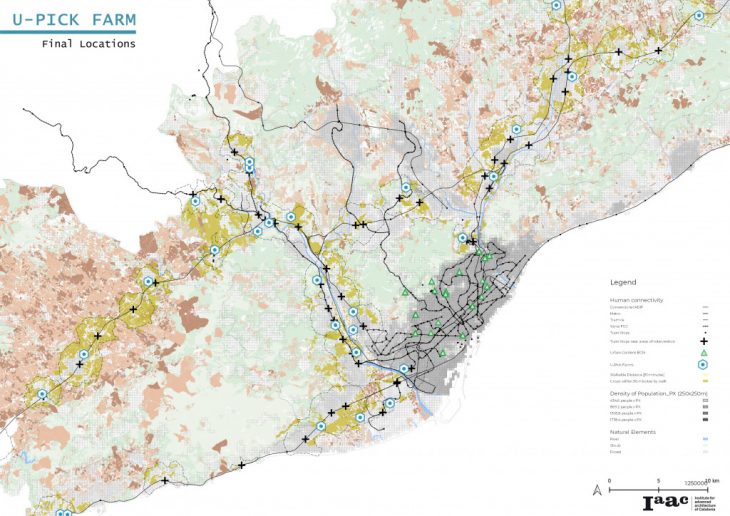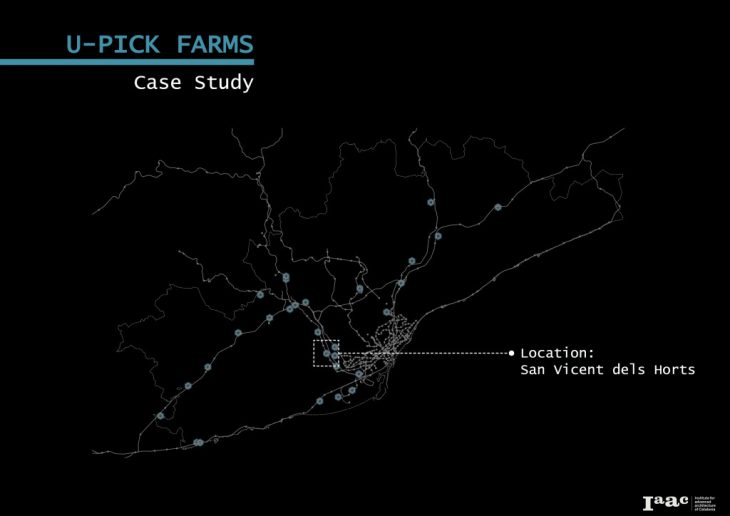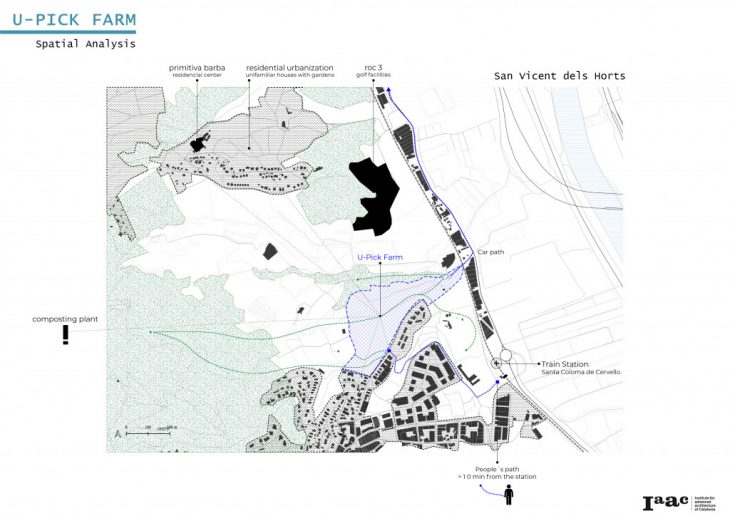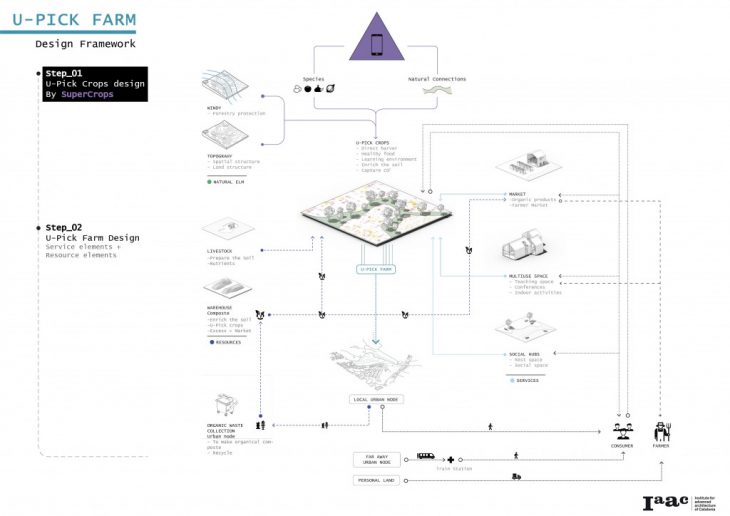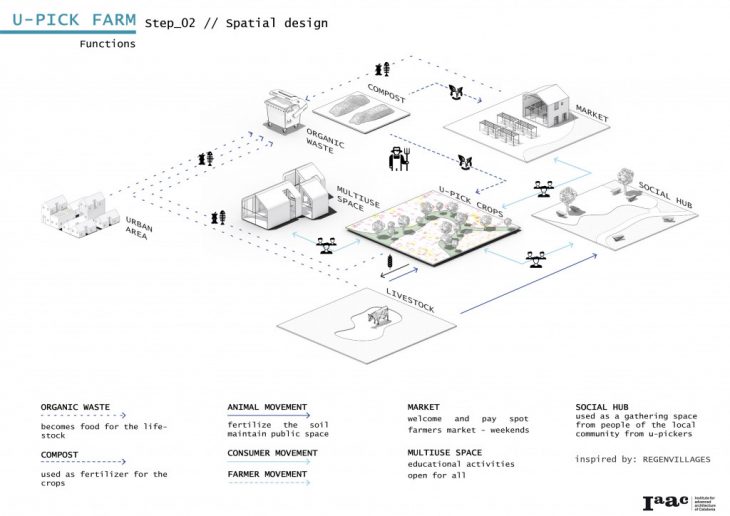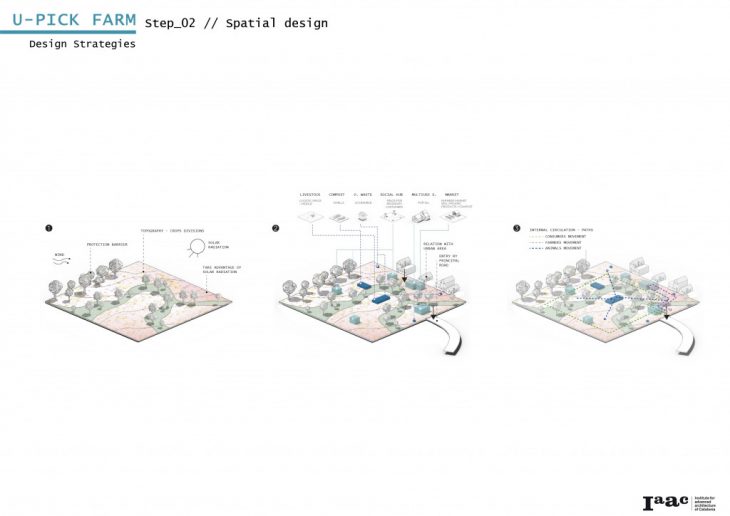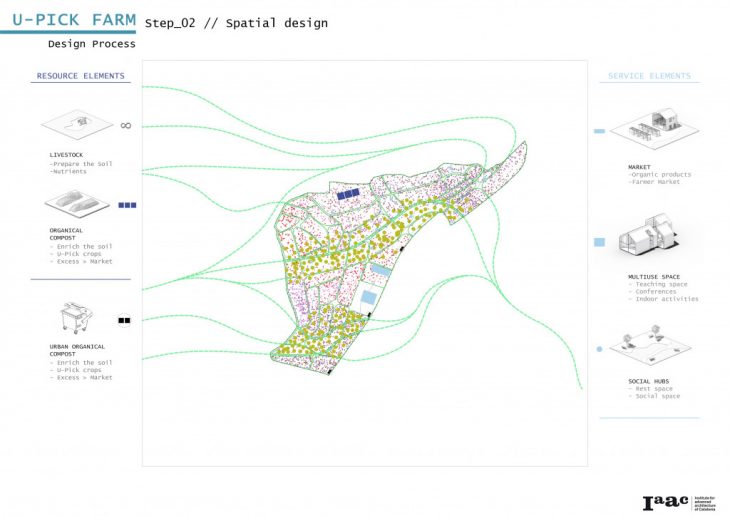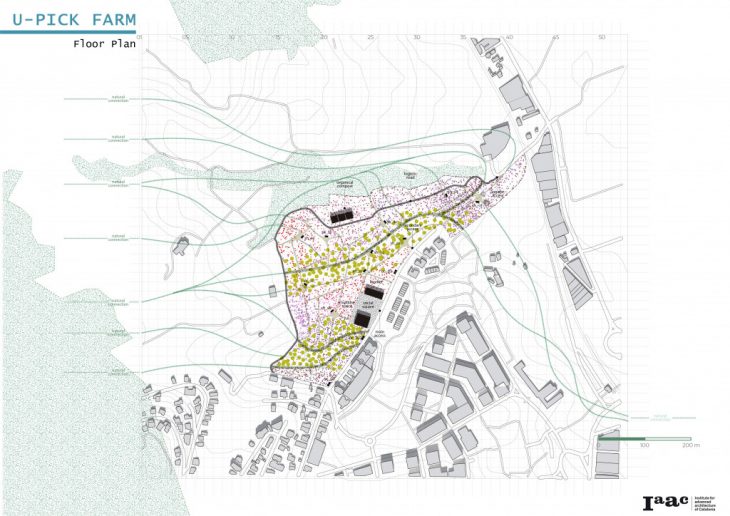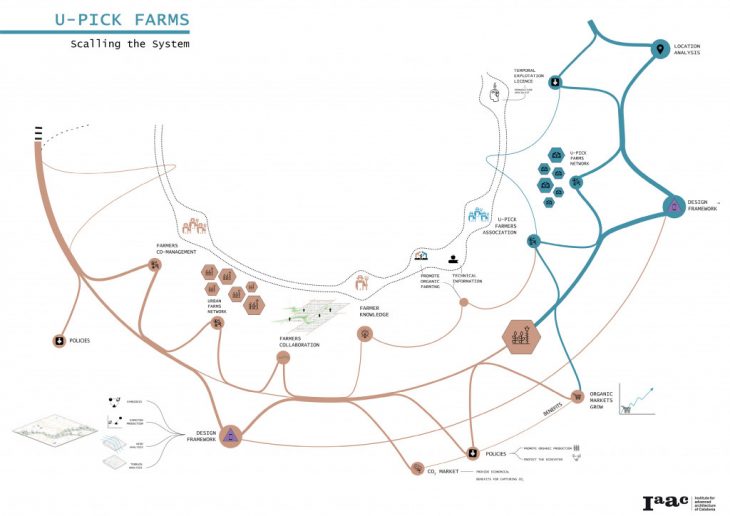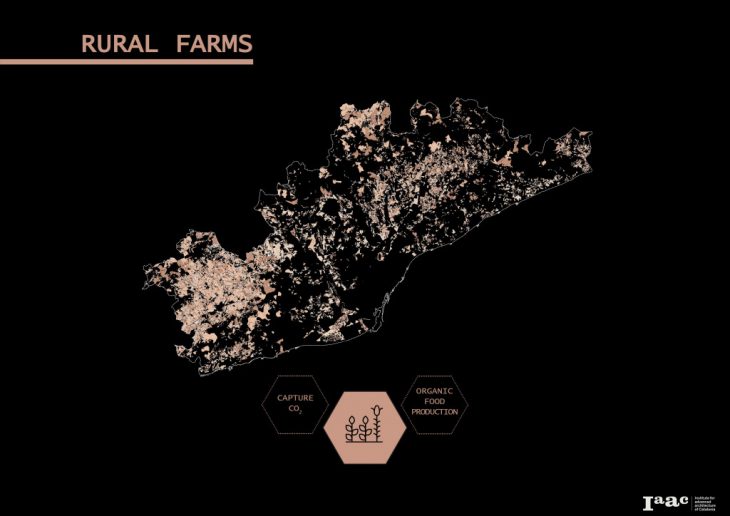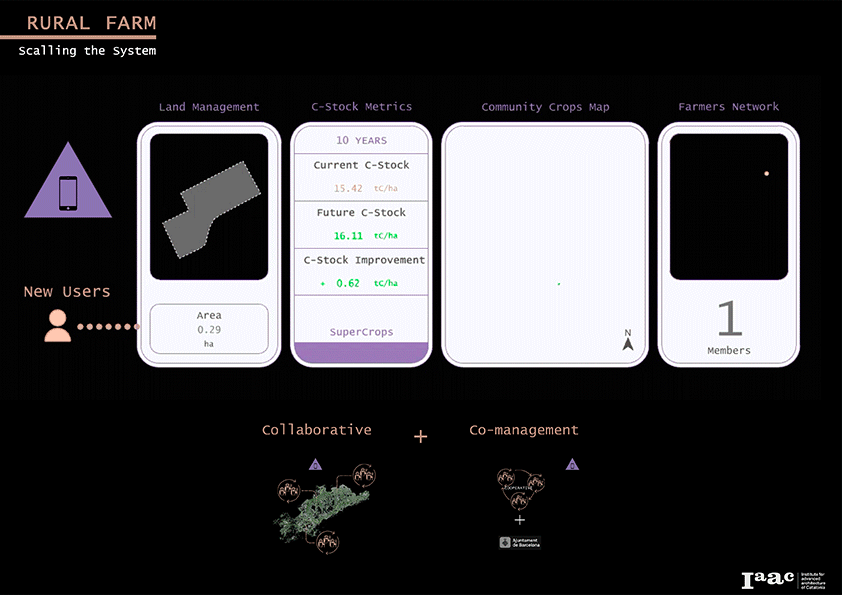A Breathing Organism, increasing Carbon Capture in Barcelona
“A Breathing Organism” is a project developed for increasing the Carbon Capture in the area of Barcelona. We consider the soils as a means to achieve that and we propose to convert conventional to regenerative agricultural lands. In this study, we worked on urban and rural scale and introduced a network of U-Pick farms, at the periphery of the city, to connect all the pieces and make them work as an organism. Thus, with the development of this system besides increasing the CO2 capture, we are managing to achieve general health and social benefits. In other words, by supporting the organic food market and connecting the farmers with the consumers, we are enhancing a change in the mentality of the people. Hence, our system is evolving throughout time in a circular way.
Introduction
Starting our project, we understood that a large amount of greenhouse emissions in Catalunya come from the agricultural field. However, depending on the implemented practices, soils and agricultural land could be a large sink or a source of CO2. With the procedure of photosynthesis, soils capture inorganic CO2 from the atmosphere and transform it into organic co2 in the soil. This procedure is actually removing 30% of our emissions every year.
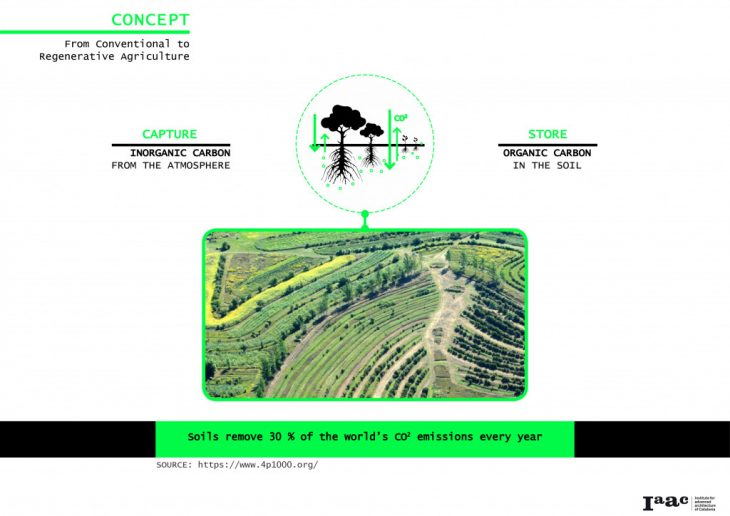
The problem with this case is that now with conventional agricultural practices, soils are getting decertified and are losing their capabilities of absorbing CO2. At the same time, their emissions increase. Thus, we need to turn to regenerative agricultural practices, avoid tilling and the use of chemicals, so that we can maximize the sequestration of the arable lands.
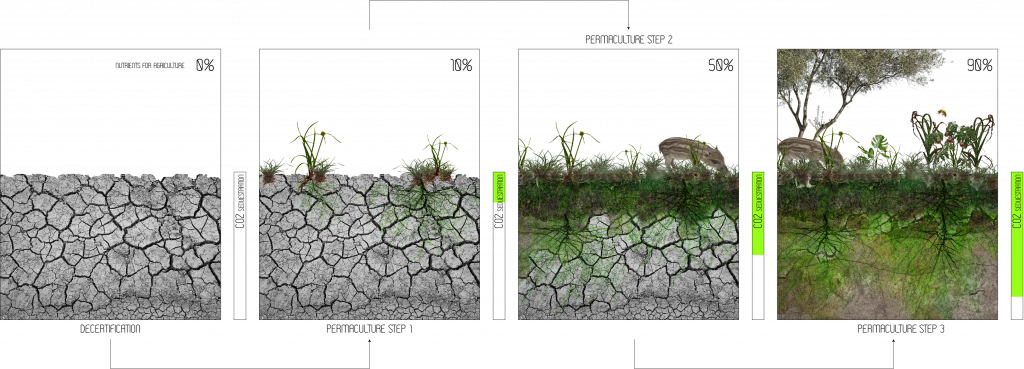
Our purpose is to go from the system on the left to a more green, organic system where the soils could have a maximum behavior in terms of C02 capture.
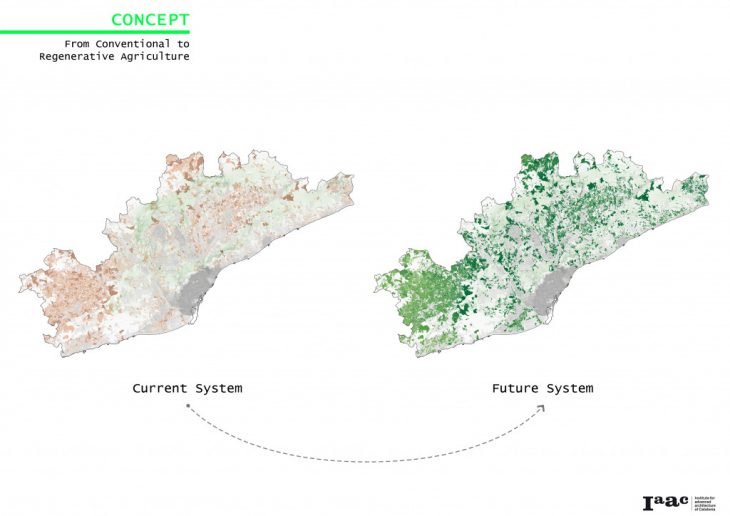
In order to transform the territory, our design is based on the natural behaviors of the system. Thus, we analyzed the natural connections and we used circuitscape software to simulate the animal paths. This procedure let us comprehend how our system could work, of course with the collaboration and co-management of the farmers.
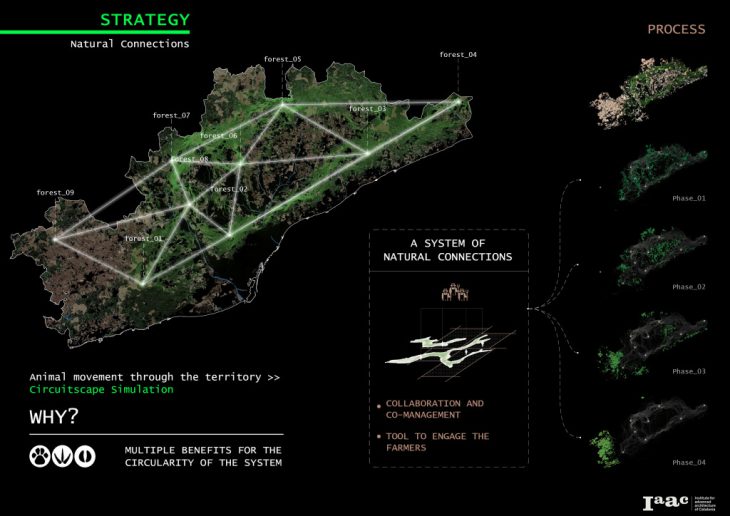
Our breathing organism consists of three interconnected elements. First, the existing urban gardens in the Metropolitan area of Barcelona, the green elements. Then the U-Pick farms, the blue elements that we introduce to the system. U-pick Farms connect the urban with the rural areas. The last component of our system are the rural farms, the orange elements that will make the most difference in terms of Co2 capture.
All parts are organically connected and dependent from each other. The functionality of each element is essential for the next ones to work. Moreover, the system evolves in terms of time, scale and impact in a continuous and circular flow.
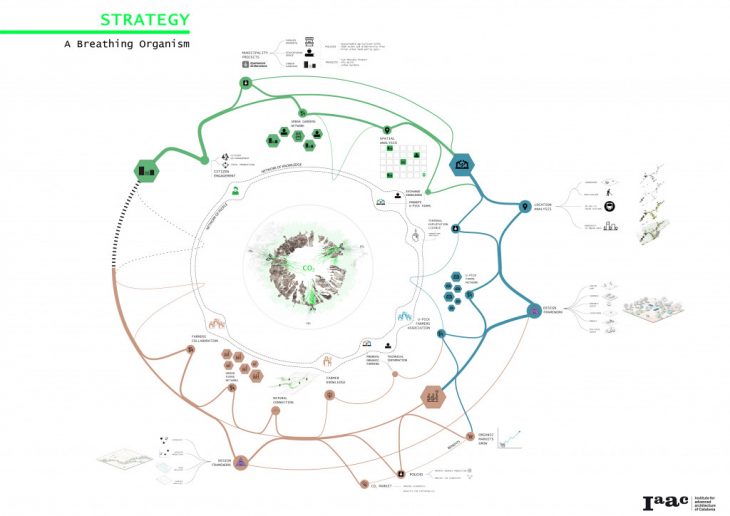
Furthermore, we created a spatial representation on how the system is evolving in terms of time when each piece will be introduced and grown.
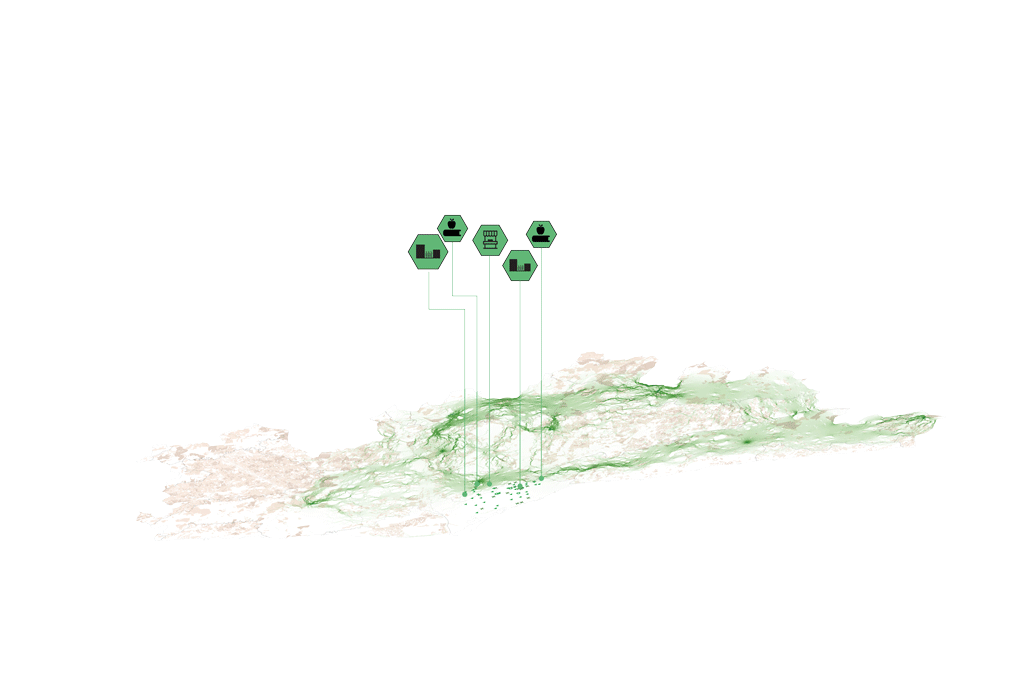
Urban Gardens
Moreover, we analyzed the existing network of urban gardens of Barcelona, promoted by the Municipality. The purpose of this network is to create co-management projects with the citizens, raise consciousness around organic food production and promote a local food system.
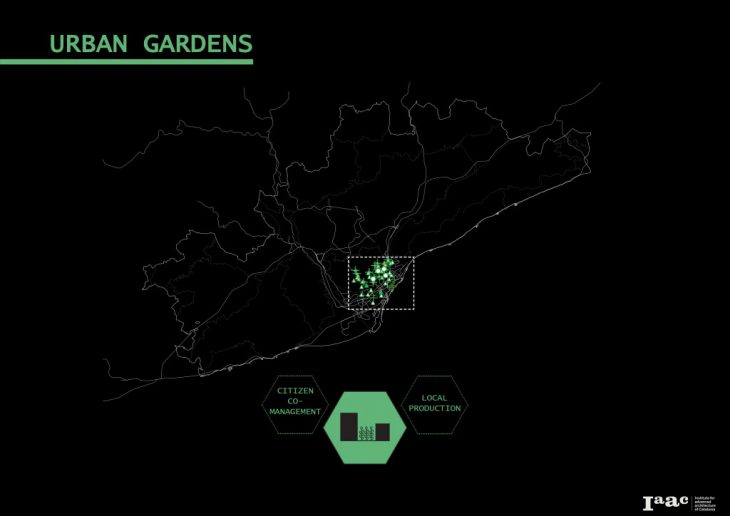
The first elements of this network are the urban gardens. These are parts of the ”Pla Buits”, a co-management project aimed at the regeneration and revitalization of the urban fabric, and the “Eje Montaña” project, which promotes agriculture in the Collserola zone. Moreover, we classified them in different typologies in relation to their context.
Next, we allocated educational spaces, where knowledge about organic agriculture is shared. Lastly we have farmers markets, which are also part of the ”Eje Montaña” project.
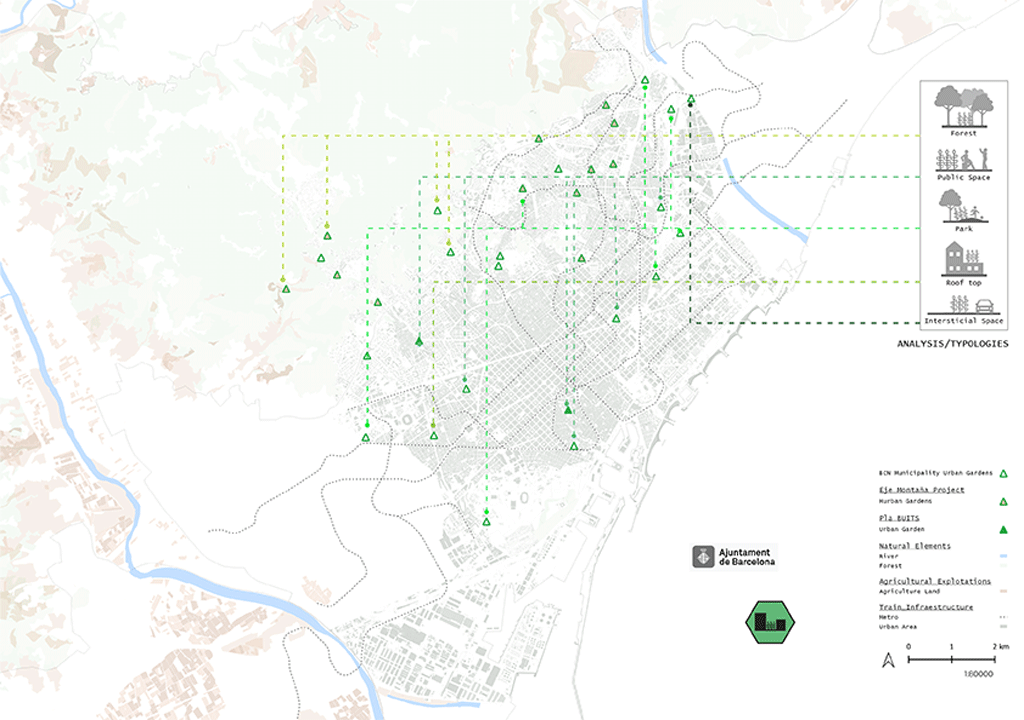
From network of Urban Gardens, we extract the different policies and functions, to support the U-Pick farms. The U-Pick farms are spaces where consumers can learn about regenerative agriculture, while picking up their own food, directly from the crops.
U- Pick Farms
U-Pick farms play a fundamental role for our whole system, as they are going to function as the main educational and connecting nodes to support the forthcoming change, from conventional to regenerative agriculture. Farmers, are sharing their knowledge about current and new practices in the field, while citizens step out from their role us only buyers of products and become farmers as well. I this way we swift the barriers between farmers and citizens, supporting our argument that potentially, anyone could become a small-scale farmer, even inside the city.
The U-Pick Farms are places where people can go from the city or the nearby urban nodes to pick- up their products. Hence, we need these areas to be easily accessible by public transport. For allocating these places, we performed an Isochrone analysis, with defines a 30 min walkable area from the train stops.
Afterwards, we used a computational tool to analyze the abandoned and the smallholders crops that are inside the Isochrone areas, in relation to their size and their accessibility.
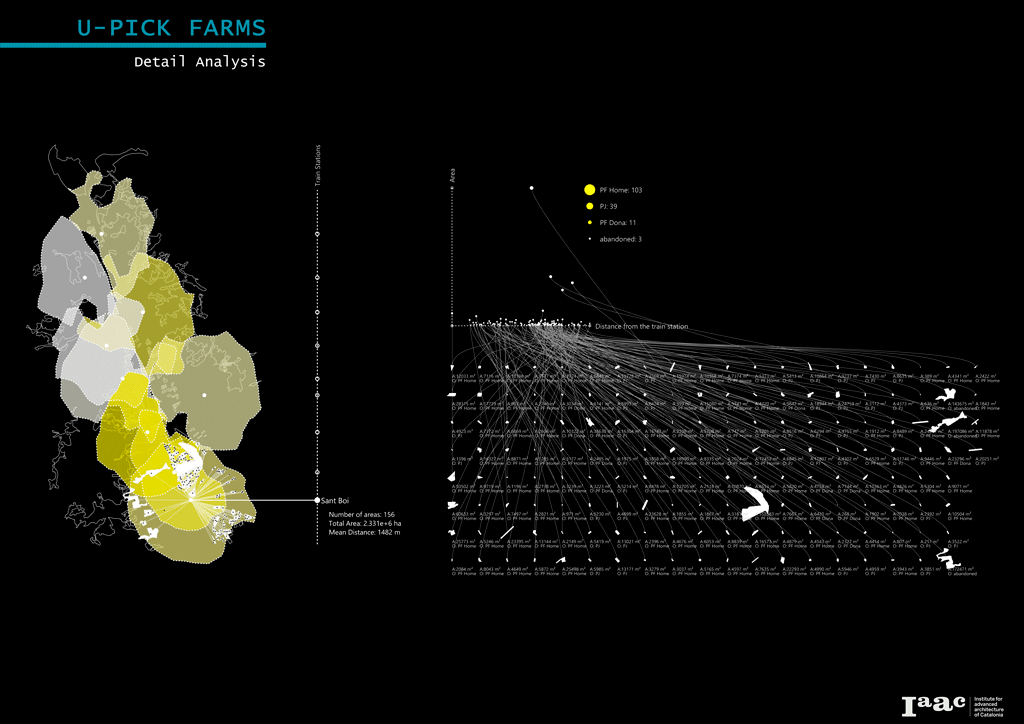
Thus, we were able to determine and propose the location of each U-pick farm in the periphery of Barcelona, and form this new blue network.
U-Pick Farms-Case Study
In order to provide a real case scenario, we selected the U-Pick Farm of San Vicent dels horts as a case study, to understand the function and develop the design of this element.
The plot selected is an abandoned crop, located between two urban nodes and at 10 minutes by walk from the train station.
We have divided the design of this element in two fundamental parts. The phase one, is focused on the design of the U-Pick crops. through a digital tool.
The second part of the design, focuses on the functionality of the U-Pick Farm, through the integration of the necessary elements. They are divided in service and resource elements.
In order to start the design process the farmer opens the digital tool and firstly, she/he searches and selects her plot.
Once it is selected the tool recognizes the plot and starts to process the relevant information to generate the U-Pick crops:
– First we need the natural connections, to integrate the plot in the whole organism.
– Second comes the topography, which is important to design the parcels of the crops following the natural slope.
Based on these, the tool defines different axes that structure and subdivide the parcels of each crop.
Then, the user defines the products and the production she/he wants and the program calculates the best spatial distribution. The main objectives here is to maximize the symbiosis between species and enrich of the soil. In addition, trees are placed along the natural connections axes to facilitate the movement of animals. We use artificial intelligence to optimize these parameters.
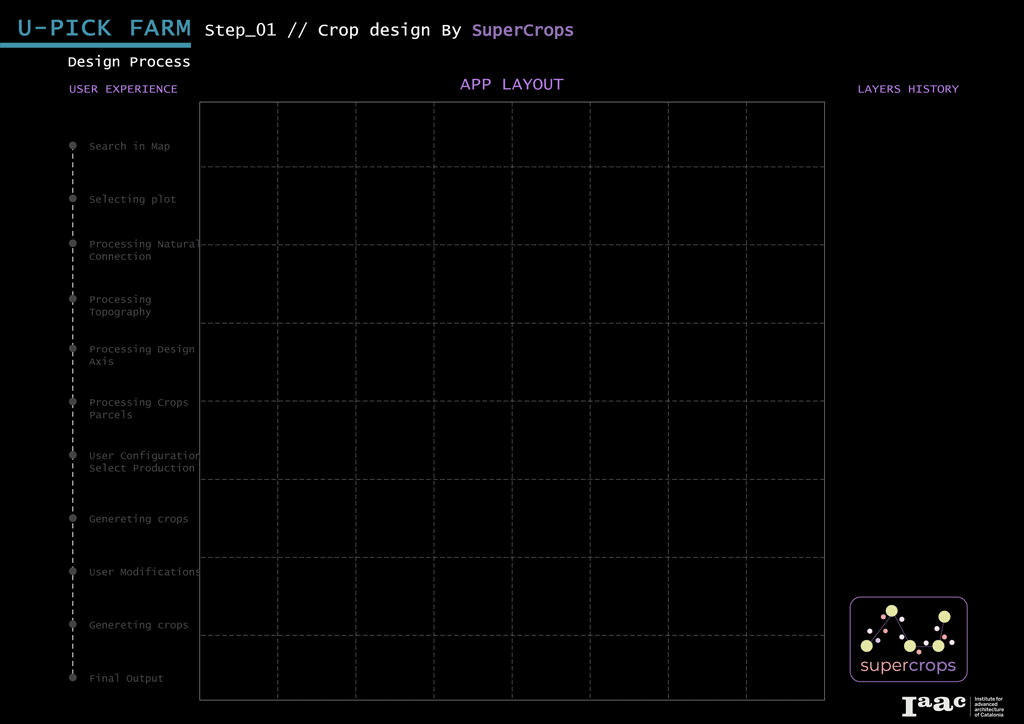
If the user is happy with the layout she/he saves it. Otherwise she/he can modify the parameters until achieve a good result.
In relation with the functions, each element has a different mission, connected to the others as you can see on the above diagram:
As service elements we have:
In the market people can pay for the harvested products or buy other organic products. The social hubs are meeting points, with the aim of enforcing human interaction. So the harvest of products becomes more playful, social and interactive. Finally, in the multifunctional space, different types of events are held, including educational conferences and specialized training for farmers.
As resource elements:
On the other hand, we allocate points to collect the organic waste from the urban nodes. Then it proceeds to the compost warehouse where is turned into compost and stored. Furthermore, livestock is a beneficial element for the circular process of regenerative agriculture.
In order to introduce this elements we use different spatial strategies.
After this process of design we achieve the final layout:
Scalling the system
The implementation of this second network allows the system to be scaled up to the third one, the rural farmers network, which will actually be the one with the greatest impact in terms of CO2 capture. The growth of organic food markets together with the change in society opens a new positive scenario for farmers that pushes them to turn from conventional to regenerative agriculture. Also, the educational function of the U-Pick farms provides them with all the necessary knowledge for this turn.
Besides benefiting from this new market, they are also taking advantages of new policies and the international CO2 market.
Rural Farms
In order to manage the change in a coordinated way, they use the digital tool, which allows them to collaborate and develop future policies together with the municipality to co-manage the changes allover the territory. This collaboration enables them to adapt the design of all the crops with respect to the natural connections, and in this way behave as a complex organism.
Our strategy for turning from conventional to regenerative agriculture on a large scale is based on the natural behavior of the region.
Therefore, we analyzed the animals’ natural flows using the same strategy as this research paper : we have processed animals’ natural paths running Circuitscape, with a resistance from the NDVI of the region.
NDVI is an index that represents the density of vegetation. We computed it from combining various satellite images, provided by sentinel for each season of the year 2019-20, in the Barcelona region.
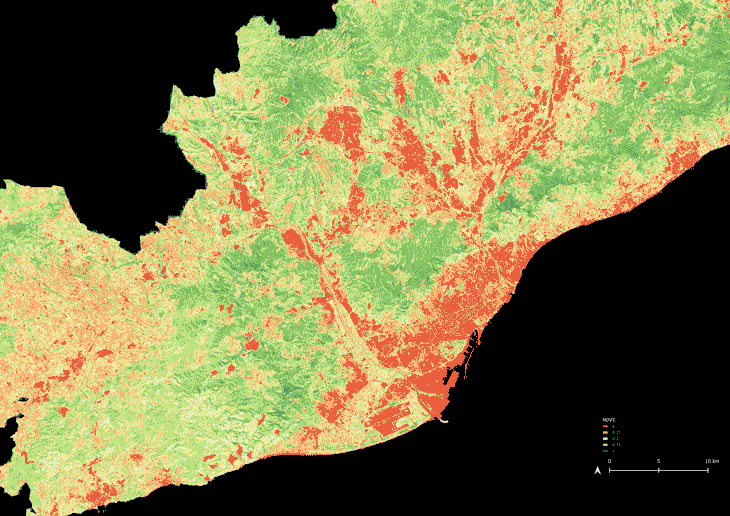
From this modification of crops we want to evaluate the impact in terms of carbon capture.
Our first step was to calculate the current crops’ carbon stock. We started from a dataset from SoilGrids, but due to its inaccuracy, we performed a linear regression with the NDVI, to be able to have a complete result. (This model has a Mean Absolute Error Rate of 0,14)
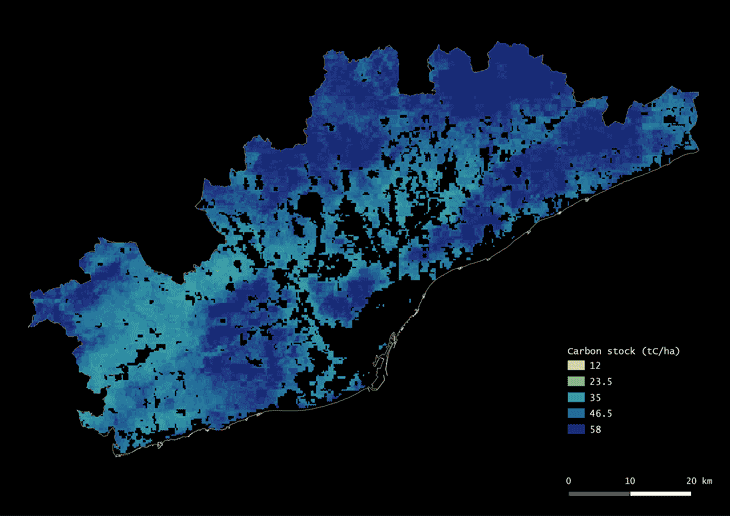
To evaluate the CO2 captured by our intervention we studied the 4 per 1000 project. The aim of the initiative is to demonstrate that agriculture, and in particular agricultural soils can play a crucial role where food security and climate change are concerned. It demonstrates that regenerative agriculture is able to increase the soil carbon stocks by 0,4% per year or 4‰.
Based on this estimation, we can calculate that if all the crops of the Barcelona region are converted to regenerative ones, in 10 years we will have 569 044 tCO2 captured.
In order to finance the modifications of these crops we propose to sell this amount of CO2 captured on the European Union Emissions Trading System. Based on the price of the ton of CO2 (25,15 €/tCO2 on the 02/17/2020) this amount of CO2 captured could generate 1,43 M€.
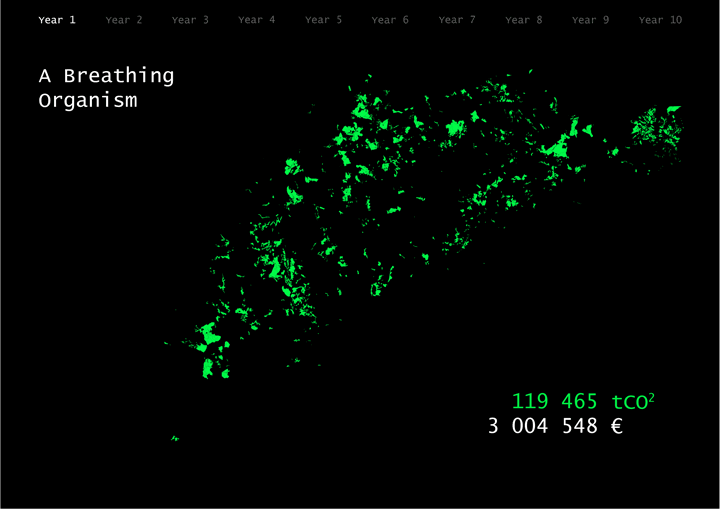
From this analysis we are able to estimate the evolution of our system, to process the amount of CO2 captured and the money generated by this capture.
We understood that we are in a point in history, when we need to rething how our cities and our infastructure should work in balance with the nature and the environment. The Breathing Organism works on this basis and seeks to be a system that could be replicated in other cities, and contexts.
A breathing Organism, increasing Carbon Capture in Barcelona, is a project of IAAC, Institute for Advanced Architecture of Catalonia developed at Master in City & Technology in 2020/21 by students: Kevin Aragon, Inigo Esteban, Diana Roussi & Tugdual Sarazin and faculty: Eduardo Rico, Mathilde Marengo & Iacopo Neri
